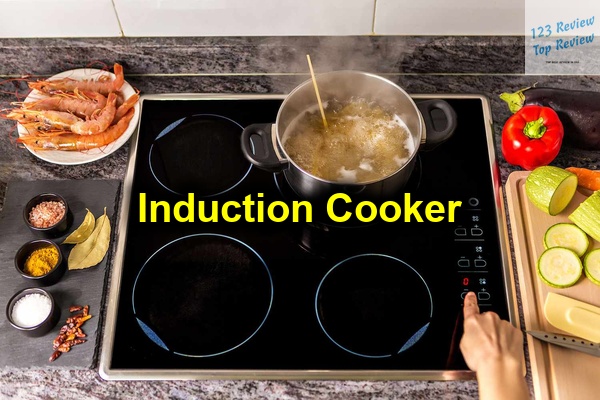As more households and professional kitchens make the switch to induction cooking, understanding how this technology works, its benefits, drawbacks, and maintenance requirements becomes essential.
In this article, 123 Review will explore everything you need to know about induction cookers, from their underlying technology to choosing the right cookware and maintaining your appliance for long-lasting use.
How Induction Cooking Works
Induction cookers rely on advanced technology that sets them apart from traditional gas and electric stoves. At the heart of induction cooking is the principle of electromagnetism, which allows for direct and efficient heating of cookware.
The Electromagnetic Principle
Induction cooking operates using electromagnetic fields to generate heat. Unlike gas or electric stoves that use an open flame or a heated coil to transfer heat to the cookware, an induction cooker uses a copper coil located beneath its smooth ceramic surface. When you turn on the induction cooker, an alternating electric current flows through the coil, creating a rapidly oscillating magnetic field above the cooktop surface.

This magnetic field remains inactive until it encounters cookware made of ferrous (iron-containing) material. The magnetic field induces electric currents, known as eddy currents, within the ferrous cookware, converting the cookware itself into a heat source. This direct heating method is what makes induction cooking so efficient, as nearly all the energy generated goes directly into heating the cookware, rather than the surrounding air or cooktop surface.
Eddy Currents and Resistive Heating
Eddy currents are circular currents that flow within the conductive material of the cookware when exposed to a changing magnetic field. These currents encounter resistance as they move through the metal, leading to resistive heating. This process of resistive heating is highly efficient, as the heat is generated directly within the cookware, allowing for quick and even cooking. The cooktop surface remains relatively cool because the heat is concentrated in the cookware, reducing the risk of burns and making cleanup easier.
The ability to generate heat directly in the cookware means that induction cookers can achieve precise temperature control, making them ideal for tasks that require delicate heat adjustments, such as simmering sauces or melting chocolate.
Advantages of Induction Cooking
Induction cooking offers a host of benefits that make it an attractive choice for both home cooks and professional chefs. Its combination of speed, efficiency, safety, and control sets it apart from traditional cooking methods.
Energy Efficiency
One of the most significant advantages of induction cooking is its superior energy efficiency. Traditional gas stoves convert only about 40-50% of their energy into usable heat, with much of the energy lost to the surrounding air. Electric stoves are slightly more efficient, but still lose a considerable amount of energy. In contrast, induction cookers can achieve up to 90% energy efficiency because the heat is generated directly within the cookware.
This high efficiency not only reduces energy consumption but also results in lower utility bills, making induction cookers an environmentally friendly choice. Additionally, since less heat is released into the kitchen environment, induction cooking can help maintain a cooler kitchen, especially during the summer months.
Precision Temperature Control
Induction cookers offer unparalleled precision in temperature control. The heat produced by an induction cooker responds instantly to changes in power settings, allowing cooks to make quick adjustments to the cooking temperature. This level of control is particularly useful for recipes that require specific temperatures, such as delicate sauces, custards, or tasks like deep frying, where maintaining a consistent temperature is crucial.
Moreover, the rapid response of induction cookers ensures that food does not overcook or burn easily, providing a level of finesse that is difficult to achieve with gas or electric stoves. Whether you need a rolling boil or a gentle simmer, an induction cooker delivers consistent results.
Safety Features
Safety is a paramount concern in any kitchen, and induction cookers excel in this area. Because the cooktop surface does not heat up directly, the risk of accidental burns is significantly reduced. Only the area in direct contact with the cookware gets warm, and even then, it cools down quickly once the cookware is removed.
Induction cookers are also equipped with several safety features, such as automatic shut-off mechanisms that activate when no cookware is detected or if the cookware is incompatible. Additionally, many models come with child lock functions, preventing accidental activation by curious little hands. These features make induction cookers a safe choice for households with children or elderly family members.
Faster Cooking Times
Speed is another major advantage of induction cooking. The direct transfer of heat from the cooktop to the cookware means that induction cookers can bring water to a boil in nearly half the time it takes on a gas or electric stove. This rapid heating capability is especially beneficial for busy families or anyone who needs to prepare meals quickly.
The speed of induction cooking also extends to the cooling process. Since the cooktop itself doesn’t retain heat, it cools down almost immediately after the cookware is removed. This feature not only adds to safety but also allows for quick cleanup and transition between cooking tasks.
Disadvantages of Induction Cooking
While induction cooking offers many benefits, it also has some drawbacks that potential buyers should consider before making the switch.
Cost of Induction Cookers
One of the primary barriers to adopting induction cooking is the cost. Induction cookers are generally more expensive than their gas or electric counterparts due to the advanced technology they employ. High-end models with multiple cooking zones, touch controls, and smart features can be particularly pricey.
However, it’s important to view this cost in the context of long-term savings. The energy efficiency of induction cookers can lead to lower utility bills over time, and the durability of these appliances means they often have a longer lifespan than traditional stoves. For many users, the initial investment is offset by these ongoing savings and the enhanced cooking experience.
Compatibility with Cookware
Induction cooking requires the use of specific types of cookware. Only pots and pans made from ferrous materials—such as cast iron, enameled steel, and certain types of stainless steel—will work on an induction cooktop. Non-magnetic materials like aluminum, copper, or glass are incompatible unless they have a magnetic layer bonded to the bottom.
This requirement may necessitate the purchase of new cookware, which can be an additional expense for those transitioning to induction cooking. It’s also worth noting that some specialty cookware, such as certain woks or tagines, may not be available in induction-compatible versions, potentially limiting cooking options.
Installation Requirements
Installing an induction cooker may require specific electrical modifications, as these appliances often demand a higher power supply than traditional stoves. Most induction cookers require a 220-240V power outlet, which may not be standard in all kitchens. Upgrading the electrical system to accommodate an induction cooker can involve additional costs for wiring and circuit upgrades.
In some cases, the installation of a new cooktop may also require modifications to countertops or cabinetry to fit the dimensions and ventilation needs of the appliance. These factors should be considered when planning a kitchen renovation or upgrade to ensure compatibility with an induction cooker.
Choosing the Right Cookware for Induction
Selecting the right cookware is crucial for maximizing the performance of your induction cooker. Understanding which materials work best and how to identify induction-compatible cookware will help you make informed decisions when stocking your kitchen.
Materials Suitable for Induction
The key requirement for induction cookware is that it must be made of, or contain, a ferrous material—meaning it should be magnetic. The most common materials that work well with induction cookers include:
- Cast Iron: Heavy and durable, cast iron is an excellent conductor of heat and works exceptionally well on induction cooktops. It retains heat efficiently, making it ideal for slow cooking or simmering dishes. However, its weight and potential to scratch the cooktop surface should be considered.
- Magnetic Stainless Steel: Not all stainless steel is compatible with induction cooktops, but many modern pots and pans are designed with a magnetic base. Stainless steel is prized for its durability, non-reactivity with food, and ease of cleaning.
- Enameled Steel: Enameled steel cookware combines the benefits of cast iron with a smooth, non-reactive surface. It’s available in a variety of colors and is generally lighter than cast iron, making it easier to handle.
- Carbon Steel: Similar to cast iron, carbon steel is magnetic and heats up quickly. It’s commonly used in woks and frying pans and is favored for its lightweight properties and ability to reach high temperatures.
Identifying Induction-Compatible Cookware
Most modern cookware designed for induction cooking will be clearly labeled as such. Look for the induction symbol on the packaging or stamped on the bottom of the cookware, which typically resembles a coil of wire.
If you’re unsure whether your existing cookware is induction-compatible, a simple test is to hold a magnet to the base of the pot or pan. If the magnet sticks firmly, the cookware is suitable for induction cooking. It’s important to ensure that the base of the cookware is flat and smooth, as this allows for maximum contact with the cooktop surface, ensuring even heat distribution and efficient cooking.
When selecting new cookware, consider the size and shape of the pots and pans in relation to the size of the induction zones on your cooktop. Using cookware that closely matches the size of the induction zone ensures optimal performance and energy efficiency.
Popular Brands of Induction Cookers
As the popularity of induction cooking continues to grow, a wide range of brands offer models to suit different needs and budgets. Whether you’re looking for a high-end appliance with advanced features or an affordable option for everyday use, there’s an induction cooker to meet your requirements.
High-End Induction Cookers
For those seeking premium performance and cutting-edge technology, several brands stand out in the high-end market:
- Miele: Known for its precision engineering and sleek design, Miele offers induction cookers with features such as flexible cooking zones, intuitive touch controls, and smart connectivity options. These models are built to last and deliver exceptional cooking results.
- Bosch: Bosch induction cookers are renowned for their reliability and innovative features. Many models include features like PowerBoost, which increases power to a cooking zone for faster boiling, and AutoChef, which maintains precise temperatures for specific cooking tasks.
- Thermador: Thermador’s luxury induction cooktops are designed with professional chefs in mind. They offer expansive cooking zones, advanced sensor technology, and a range of customizable settings to suit any culinary task. Thermador cooktops also integrate seamlessly into modern kitchens with their minimalist design.
Affordable Induction Options
For those on a budget, there are plenty of affordable induction cookers that offer excellent performance without breaking the bank:
- Duxtop: Duxtop is a popular brand for budget-friendly induction cooktops that are portable and easy to use. These models are ideal for small kitchens, RVs, or as an additional cooking surface in larger kitchens. Duxtop cookers are reliable and offer many of the same benefits as more expensive models.
- Hamilton Beach: Hamilton Beach offers compact and affordable induction cookers that are perfect for everyday use. Their models are user-friendly, with straightforward controls and a variety of power settings to handle different cooking tasks.
- IKEA: IKEA’s induction cooktops provide a good balance of quality and affordability. Designed to fit seamlessly into any kitchen, these models are a great option for those looking to upgrade their cooking appliances on a budget. IKEA also offers a range of induction-compatible cookware.
Features to Look for in Induction Models
When choosing an induction cooker, consider the following features to ensure you select a model that meets your cooking needs:
- Number of Cooking Zones: Induction cookers come with a varying number of cooking zones, typically ranging from two to five. Consider your cooking habits and kitchen space when deciding how many zones you need. Some high-end models offer flexible zones that can accommodate different sizes of cookware.
- Power Settings: Look for a model with adjustable power settings to give you more control over cooking temperatures. Features like PowerBoost allow you to quickly increase heat for tasks like boiling water, while lower settings are ideal for simmering and keeping food warm.
- Safety Features: Ensure the model you choose has essential safety features such as automatic shut-off, child lock, and residual heat indicators. These features provide peace of mind, especially in households with children or elderly family members.
- Ease of Use: Induction cookers with intuitive touch controls, digital displays, and programmable settings make cooking more convenient. Some models also offer smart connectivity, allowing you to control the cooktop remotely via a smartphone app.
Induction Cooking Techniques
Induction cookers are versatile appliances that can handle a wide range of cooking techniques. Understanding the methods best suited for induction cooking and some helpful tips will enhance your culinary experience.
Cooking Methods Best Suited for Induction
Induction cooking is highly adaptable and can be used for various cooking methods, including:
- Sautéing and Stir-Frying: The rapid response of induction cookers makes them perfect for high-heat cooking methods like sautéing and stir-frying. The precise temperature control allows for quick adjustments, preventing food from burning while ensuring even cooking.
- Boiling and Simmering: Induction cookers can bring liquids to a boil in a fraction of the time it takes on gas or electric stoves. They’re also excellent for simmering, as the heat can be reduced to a precise low level, preventing overcooking or scorching.
- Frying: Whether you’re deep-frying or pan-frying, induction cookers maintain a consistent temperature, which is essential for achieving crispy, evenly cooked results. The ability to maintain precise temperatures also means you can avoid overheating the oil, reducing the risk of burning.
- Braising and Stewing: Induction cookers are ideal for slow-cooking methods like braising and stewing, where maintaining a consistent low temperature is key. The even heat distribution ensures that meat and vegetables cook thoroughly and retain their moisture.
- Melting and Tempering: Tasks like melting chocolate or tempering butter require gentle, steady heat. Induction cookers excel at maintaining low temperatures, making them ideal for these delicate cooking tasks.
Tips for Effective Induction Cooking
To get the most out of your induction cooker, consider these tips:
- Use the Right Cookware: Ensure your cookware is induction-compatible and has a flat, smooth base. This will maximize contact with the cooktop and ensure efficient heat transfer.
- Preheat with Care: While induction cookers heat up quickly, some cooking tasks, like searing meat, may benefit from preheating the pan. However, avoid overheating, as this can damage the cookware or cause food to stick.
- Take Advantage of Precision Control: Use the precise temperature settings to your advantage, especially when cooking delicate dishes. Experiment with lower heat settings for simmering and higher settings for quick boiling or frying.
- Keep the Cooktop Clean: Since spills don’t burn onto the cooktop, clean up messes as they occur to prevent them from becoming stubborn stains. A clean cooktop ensures better performance and prevents scratching.
- Use a Lid: When boiling or steaming, using a lid helps retain heat and speeds up cooking times. This is especially useful when you want to bring liquids to a boil quickly.
Maintenance and Care for Induction Cookers
Proper maintenance and care are essential for keeping your induction cooker in top working condition. Regular cleaning and troubleshooting common issues can extend the life of your appliance and ensure it continues to perform efficiently.
Cleaning Guidelines
Cleaning an induction cooker is relatively easy, thanks to its smooth, flat surface. Since the cooktop doesn’t get hot enough to burn spills, they can be wiped away without much effort. Follow these guidelines for effective cleaning:
- Daily Cleaning: After each use, wipe the cooktop with a soft, damp cloth to remove any food residues or spills. Use a mild detergent if necessary, but avoid abrasive cleaners or scouring pads, as they can scratch the surface.
- Deep Cleaning: For more stubborn stains or grease, use a specially formulated ceramic cooktop cleaner. Apply the cleaner with a soft cloth, then buff the surface to a shine. Regular deep cleaning helps maintain the cooktop’s appearance and performance.
- Prevent Scratches: To prevent scratches, avoid sliding heavy cookware across the surface. Lift pots and pans when moving them. Also, ensure the bottom of your cookware is clean and free of debris that could scratch the cooktop.
Troubleshooting Common Issues
While induction cookers are generally reliable, you may occasionally encounter issues. Here are some common problems and their solutions:
- Cooktop Doesn’t Recognize Cookware: If your induction cooker isn’t recognizing the cookware, check that the pot or pan is induction-compatible and that the base is flat. If the cookware is suitable, try repositioning it on the cooktop.
- Uneven Heating: Uneven heating can occur if the cookware base isn’t completely flat or if the size of the cookware doesn’t match the induction zone. Ensure the cookware is the correct size for the cooking zone and sits evenly on the cooktop.
- Error Codes: Many induction cookers display error codes to indicate specific issues, such as overheating or a power supply problem. Refer to the user manual for a list of error codes and their meanings. Common solutions include resetting the cooker by turning it off and on again or ensuring proper ventilation around the cooktop.
- Buzzing or Humming Noise: Some induction cookers may produce a buzzing or humming sound during operation, especially at high power settings. This is normal and typically results from the vibrations of the cookware’s metal. Reducing the power level or ensuring the cookware base is thick and heavy can help minimize the noise.
The Rise in Popularity of Induction Cooking
Induction cooking has steadily gained popularity over the past decade, driven by its efficiency, safety, and the growing awareness of energy conservation. As more consumers seek out environmentally friendly and cost-effective cooking solutions, induction cookers have become a go-to choice in modern kitchens.
Trends in Consumer Preferences
Several trends have contributed to the rise of induction cooking. First, the increased focus on energy efficiency has made consumers more aware of the advantages of induction cookers over traditional gas and electric stoves. With energy costs on the rise and a greater emphasis on reducing carbon footprints, the energy efficiency of induction cookers is a significant draw.
Second, the demand for convenience and speed in the kitchen has led many to choose induction cooking. The ability to cook meals faster without sacrificing control or safety appeals to busy professionals, parents, and anyone looking to streamline their cooking process.
Finally, the sleek, modern design of induction cooktops fits well with contemporary kitchen aesthetics. As kitchen design trends continue to favor minimalist and integrated appliances, induction cookers have become a popular choice for those seeking a clean, clutter-free look.
Induction vs. Traditional Cooking Methods
When comparing induction cooking to traditional methods, several factors highlight the advantages of induction technology:
- Speed: Induction cookers heat up faster than gas or electric stoves, significantly reducing cooking times.
- Efficiency: With up to 90% energy efficiency, induction cookers waste less energy, leading to lower utility bills and a smaller environmental impact.
- Safety: The cool-to-the-touch surface and built-in safety features make induction cookers safer than traditional stoves, particularly in households with children.
- Precision: Induction cookers offer unmatched control over cooking temperatures, allowing for more precise and consistent results.
However, the higher upfront cost and the need for compatible cookware may deter some from making the switch. Despite these considerations, the long-term benefits of induction cooking—such as energy savings, enhanced safety, and superior cooking performance—make it an increasingly popular choice in both residential and commercial kitchens.
In conclusion, the induction cooker represents the future of cooking technology, offering a compelling combination of efficiency, precision, and safety. Whether you’re a professional chef or a home cook, the benefits of induction cooking make it a worthwhile investment that can transform your culinary experience. By understanding how induction cooking works, choosing the right cookware, and following proper maintenance practices, you can enjoy the full advantages of this modern kitchen appliance.





